|
|
| | My Favourite Planet > English > Europe > Greece > Macedonia > Stageira & Olympiada > Stageira gallery |
| Stageira & Olympiada |
Ancient Stageira gallery |
 |
 |
19 of 38 |
 |
 |
|
| |
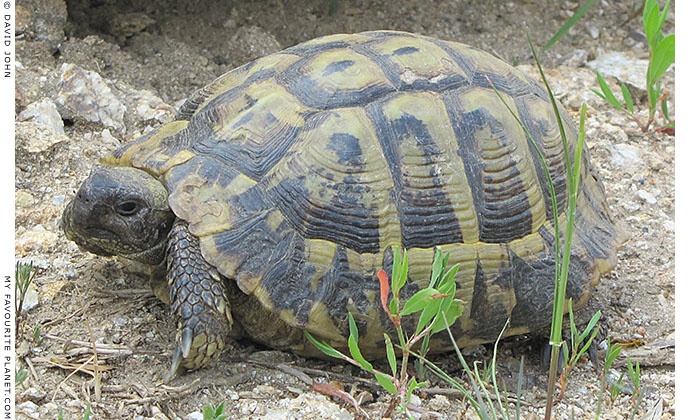
Tortoise break: A Greek tortoise (Testudo graeca) explores Ancient Stageira. |
| |
The Greek tortoise (Testudo graeca), also known as the spur-thighed tortoise, can be found all over the Mediterranean countryside, and even in the middle of cities such of Athens (see photo below). There are thought to be as many as 20 sub-species of this shelled reptile, which can grow up to 18 cm long and live for more than 50 years.
Despite their apparent ubiquity, tortoises are endangered by human activity such as farming and continuous urbanizaton. They are also captured to be sold as pets worldwide.
The tortoise's most famous role in western culture is as the slow-but-steady racer in Aesop's fable of The tortoise and the hare. [1]
In a Greek myth, the nymph Chelone (Χελώνη, Xelone, tortoise) spurned Hermes' invitation to the wedding of Zeus and Hera, preferring to stay at home. As a punishment, Hermes turned her and her house into a tortoise, condemning her to carry her home around with her, and giving the animal its name. [2]
According to another myth, the god Hermes, one of whose symbols was the tortoise, is credited with inventing the lyre when he stretched strings of sheep-gut across the shell of a dead tortoise. He gave his new invention to Apollo (see photo below) as compensation for cattle he had stolen from him. Later Apollo taught Orpheus to play the instrument. [3]
An anecdote related by the Roman author Pliny the Elder (23-79 AD) claims that a tortoise was involuntarily responsible for the death of the Athenian playwright Aeschylus (Αἰσχύλος, circa 525-456 BC) when it was dropped on his head by an eagle. A rather undignified end for the great writer:
"This eagle has the instinct to break the shell of the tortoise by letting it fall from aloft, a circumstance which caused the death of the poet Aeschylus. An oracle, it is said, had predicted his death on that day by the fall of a house, upon which he took the precaution of trusting himself only under the canopy of the heavens."
Pliny the Elder, The Natural History, Book 10, chapter 3 [4].
Pliny does not tell us about the fate of the tortoise.
"I took my lyre and said:
Come now, my heavenly
tortoise shell: become
a speaking instrument"
Fragment of a poem by Sappho, 7th century BC. |
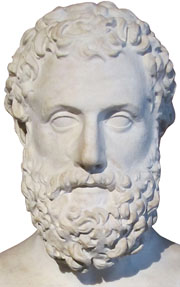
Killed by a tortoise?
Marble Portrait bust of
the Athenian tragedian
Aeschylus (circa 525-456
BC). Roman period copy
of a Greek original of the
4th century BC.
Neues Museum, Berlin.
Inv. No. Sk 313. |
| |
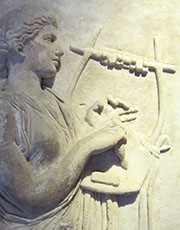
A muse playing a cithara.
Detail of a 2nd century BC marble relief, from Manyas, Turkey.
Istanbul Archaeological Museum. |
|
| |
| |
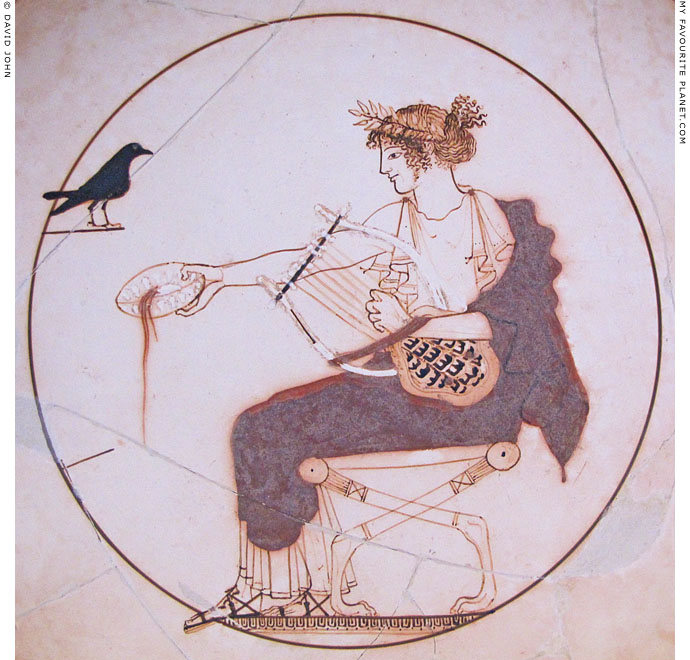
The tondo on the inside of a white-ground kylix (drinking cup) showing Apollo playing a seven-string
lyre with a sound-board made of a tortoise shell. The god wears a wreath of laurel or myrtle leaves,
a white peplos over which is a red himation (cloak), and sandals. He sits on a diphros (folding stool)
with lion-paw legs. With his right hand he pours wine on the ground as a libation, thought to be an
offering to the earth goddess Gaia. The black bird facing him has been variously identified as a crow,
raven or jackdaw. It has been suggested that the bird may be an allusion to his love affair with
Koronis (Κορωνίς, crow or raven), the mother of Apollo's son, the healing god Asklepios.
Made by an anonymous Athenian vase painter 480-470 BC, this exquisitely painted kylix
(diameter 18 cm) was found in a tomb at the site of the present Museum of Delphi.
Archaeological Museum of Delphi, Greece. Inv. No. 8140. |
| |
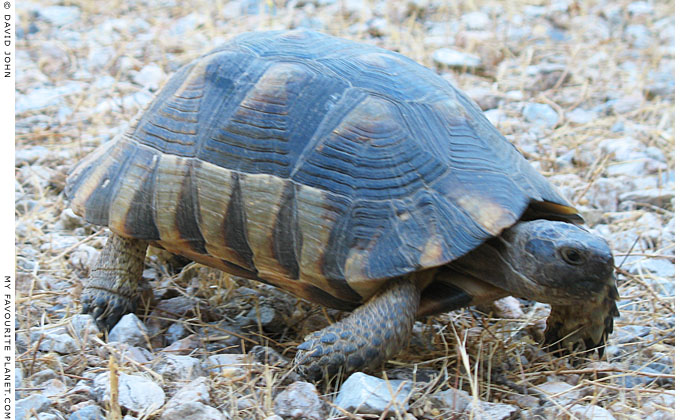
Another photo for tortoise fans. This one lives in the Ancient Agora in Athens.
See yet another photo of a tortoise in Selçuk, Turkey. |
| |
| |

A silver coin of Aegina, known as a tortoise.
Numismatic Museum, Athens. |
Ancient Stageira
gallery |
Notes, references and links |
 |
|
1. The tortoise and the hare by Aesop
Aesop (Greek: Αἴσωπος, Aisopos, circa 620-564 BC), a story-teller credited with writing several tales known as Aesop's Fables. According to Aristotle and Herodotus he was a slave on Samos.
"A Hare one day ridiculed the short feet and slow pace of the Tortoise, who replied, laughing: 'Though you be swift as the wind, I will beat you in a race.' The Hare, believing her assertion to be simply impossible, assented to the proposal; and they agreed that the Fox should choose the course and fix the goal.
On the day appointed for the race the two started together. The Tortoise never for a moment stopped, but went on with a slow but steady pace straight to the end of the course. The Hare, lying down by the wayside, fell fast asleep.
At last waking up, and moving as fast as he could, he saw the Tortoise had reached the goal, and was comfortably dozing after her fatigue.
Slow but steady wins the race."
The hare and the tortoise by Aesop, translated by George Fyler Townsend (1814-1900), 1867. At wikisource.
1b. Purported statue of Aesop in Rome (photo, right)
Statue of a hunchback dwarf, made of white, fine-grained Luna marble. 2nd century AD. Height 56 cm.
Found in 1758 in the Baths of Caracalla, Rome, and acquired by Cardinal Alessandro Albani for his collection of antiques in the Villa Albani. Looted by Napoleon, it was later returned to the private collection of Alexander Torlonia, and is now in the Villa Albani-Torlonia, Rome. It is not on public display (which is why it is difficult to find modern photos of it), but a cast replica is exhibited at the Pushkin State Museum of Fine Arts, Moscow.
The identification of the statue as Aesop is far from certain, and it has also been suggested that it represents a jester of the imperial court.
See: Lisa Trentin, What's in a Hump? Re-examining the Hunchback in the Villa Albani-Torloniamore.
The Cambridge Classical Journal, Volume 55, December 2009, pages 130-156. At academia.edu.
2. Hermes turns the nymph Chelone into a tortoise
"For his wedding with Juno [Hera], Jupiter [Zeus] ordered Mercurius [Hermes] to invite all the gods, the men and the animals to the wedding. Everyone invited by Mercurius came, except for Chelone who did not deign to be there, mocking the wedding. When Mercurius noticed her absence, he went back down to the earth, threw in the river the house of Chelone that was standing over the river and changed Chelone into an animal that would bear her name. Chelone is said testudo (tortoise) in Latin."
Maurus Servius Honoratus (4th century AD), Commentary on the Aeneid of Virgil, 1, 505. |
|
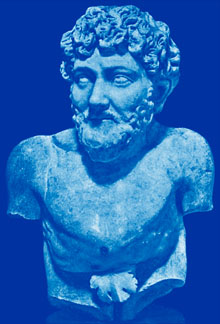
Marble statue of a dwarf, thought
to be a portrait of Aesop [1b].
Villa Albani-Torlonia, Rome.
From Greek & Roman portraits
by Anton Hekler (1882-1940).
Putman, New York, 1912.
At the Internet Archive. |
|
| |
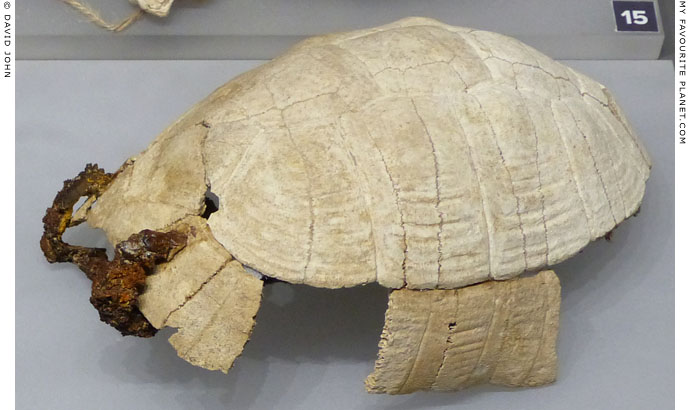
The remains of a lyre with a tortoiseshell soundboard, from Ancient Corinth.
Corinth Archaeological Museum.
|
3. Hermes makes the first lyre from a tortoise shell
Pausanias wrote that this happened on Mount Khelydorea [ὄρος Χελυδόρεα], near Herme's traditional birthplace on Mount Kyllene (Κυλλήνη) in Arcadia. The name of the mountain has been translated as Mountain of the flayed tortoise or Rich in Tortoises.
"Adjoining Cyllene is another mountain, Chelydorea, where Hermes is said to have found a tortoise, taken the shell from the beast, and to have made from it a lyre."
Pausanias, Description of Greece, Book 8, chapter 17, section 5. At Perseus Digital Library.
There are several accounts of this myth by ancient writers, the oldest of which is the Homeric Hymn 4 to Hermes (7th-4th century BC). They can be read at:
theoi.com/Olympios/HermesMyths.html#Lyre. At the Theoi Project.
This kind of lyre (λύρα), the chelys (χέλυς), from the Greek Χελώνη (tortoise), is known in German as Schildkrötenleier (tortoise lyre).
"The clever device of the lyre, it is said, was invented by Hermes, who constructed it of two horns and a crossbar and a tortoise-shell; and he presented it first to Apollo and the Muses, then to Amphion of Thebes."
Philostratus the Elder, "Amphion", Imagines, Book I, No. 10. In: Arthur Fairbanks, Philostratus, Imagines and Callistratus, Descriptions, page 40-45. Loeb Classical Library. William Heinemann Ltd, London; G. P. Putnam's Sons, New York, 1931. At the Internet Archive.
Pausanias also mentioned that the shells of tortoises reared Mount Parthenios (Παρθένιον) in Arcadia were suitable for lyres:
"Mount Parthenius rears also tortoises most suitable for the making of harps [λύρας, lyres]; but the men on the mountain are always afraid to capture them, and will not allow strangers to do so either, thinking them to be sacred to Pan."
Pausanias, Description of Greece, Book 8, chapter 54, section 7. At Perseus Digital Library.
4. Pliny, Aeschylus and the tortoise
The Athenian playwright Aeschylus (Ancient Greek, Αἰσχύλος, Aiskilos; circa 525/524 BC – circa 456/455 BC) is considered by some to be the father of tragedy.
According to Pausanias, "Aeschylus himself said that when a youth he slept while watching grapes in a field, and that Dionysus appeared and bade him write tragedy. When day came, in obedience to the vision, he made an attempt and hereafter found composing quite easy."
Pausanias, Description of Greece, Book 1, chapter 21, section 2. At Perseus Digital Library.
In later life he staged plays at the court of the tyrant Hiero I of Syracuse in Sicily, and eventually died at the Sicilian city of Gela. However, there are no other sources or evidence for the cause of his death.
Here is the opening to Pliny's discussion on "The different kinds of Eagles":
"Of all the birds with which we are acquainted, the eagle is looked upon as the most noble, and the most remarkable for its strength.
There are six different kinds; the one called 'melanaetos' by the Greeks, and 'valeria' in our language, the least in size of them all, but the most remarkable for its strength, is of a blackish colour. It is the only one among all the eagles that feeds its young; for the others, as we shall mention just now, drive them away; it is the only one too that has neither cry nor murmur; it is an inhabitant of the mountains.
The second kind is the pygargus, an inhabitant of the cities and plains, and distinguished by the whiteness of its tail.
The third is the morphnos, which Homer also calls the 'perenos', while others again call it the 'plangus' and the 'anataria'; it is the second in size and strength, and dwells in the vicinity of lakes.
Phemonoë, who was styled 'the daughter of Apollo', has stated that this eagle has teeth, but that it has neither voice nor tongue; she says also that it is the blackest of all the eagles, and has a longer tail than the rest; Boeus is of the same opinion.
This eagle has the instinct to break the shell of the tortoise by letting it fall from aloft, a circumstance which caused the death of the poet Aeschylus. An oracle, it is said, had predicted his death on that day by the fall of a house, upon which he took the precaution of trusting himself only under the canopy of the heavens."
Pliny the Elder (23-79 AD), The Natural History, Book 10, "The history of the birds", chapter 3, "The different kinds of Eagles". At Perseus Digital Library.
The British historian Peter Green has wrily commented that the eagle's mistaking the poet's head for a stone "can hardly be taken as evidence of baldness". (Peter Green, A concise history of Ancient Greece to the close of the Classical era, page 122. Thames and Hudson, London, 1973.)
Scholars are still debating what kind of "eagle" Pliny was describing, and whether it was actually a type of buzzard or vulture. |
|
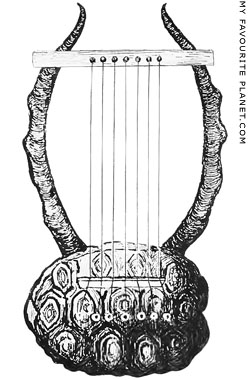
Drawing of a lyre with a
tortoise-shell sound board.
Source: "Lyre of Amphion", drawing
by M. L. Fairbanks, as frontispiece
to Arthur Fairbanks, Philostratus,
Imagines and Callistratus,
Descriptions. |
|
Photos, maps and articles: copyright © David John,
except where otherwise specified.
Additional photos: copyright © Konstanze Gundudis
All photos and articles are copyright protected.
Images and materials by other authors
have been attributed where applicable.
Please do not use these photos or articles without permission.
If you are interested in using any of the photos for your website,
project or publication, please get in contact.
Higher resolution versions are available on request.
My Favourite Planet makes great efforts to provide
comprehensive and accurate information across this
website. However, we can take no responsibility for
inaccuracies or changes made by providers of services
mentioned on these pages. |
| |
 |
Visit the My Favourite Planet Group on Facebook.
Join the group, write a message or comment,
post photos and videos, start a discussion... |
|
|
| |
|
|
| |
| |
 |
| |
 |
| |
 |
| |
 |
| |
George Alvanos
rooms in
Kavala's historic Panagia District
Anthemiou 35,
Kavala, Greece
kavalarooms.gr
|
| |
 |
| |
 |
| |
Olive Garden Restaurant
Kastellorizo,
Greece
+30 22460 49 109
kastellorizo.de
|
| |
Papoutsis
Travel Agency
Kastellorizo,
Greece
+30 22460 49 286
greeklodgings.gr
|
| |
|